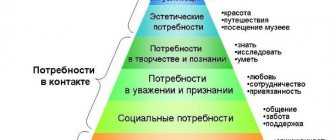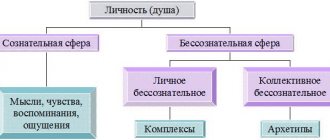Functions and theories of motivation
Needs perform a motivating function of activity and behavior, and motives perform a controlling function.
The problem of causality (determination) of human behavior and actions has been the subject of many theories of personality. Therefore, in science there are many theories of motivation.
Behaviorist (B. Skinner). Considers the need, the need of the body (to eat, drink, have a normal temperature, etc.), caused by the deviation of physiological parameters from the optimal level, as the basis of activity. Behavior is motivated by the consequences of actions and past experiences. So, if the action led to the release of the tension of the need, then the probability of repeating the action increases, and if this did not happen, then the probability of repeating the action decreases. Psychoanalytic (3rd Freud). The motivation for behavior, according to the third Freud, is based on the desire to satisfy innate instincts (life and death) - the physical needs of the body. Instincts provide a person with energy, which is the source of his activity. At the same time, if satisfying a need is impossible for some reason (moral restrictions, fear of punishment, etc.), then the energy of instinct can be directed in another direction - to carry out activities not related to instinct (politics, creativity, business etc.). This direction of instinctive energy in another direction is called sublimation.
Humanistic (A. Maslow, K. Rogers). According to humanistic theory, the motivating force of human behavior lies in the recognition of one's own abilities and potential. Cognitive (L. Festinger). According to representatives of this direction, personal behavior is motivated by the desire for consistency between knowledge about the world and about oneself, i.e. to consonance. Cognitive inconsistency is experienced by a person as a state of discomfort, and he strives to get rid of it in order to restore internal cognitive harmony. This desire is a strong motivating factor for human behavior and his attitude towards the world. Dissonance can be resolved in three ways: changing one of the cognitions, reducing its importance, or adding a new cognition.
Activity (A.N. Leontyev). According to the concept of A.N. Leontiev, the motivational sphere of personality, like other psychological characteristics, has its origins in practical activity. Sublimation is the direction of instinctive energy to perform actions not related to the direct satisfaction of needs.
Cognition is any knowledge, opinion, or belief about the environment, oneself, or one's behavior. Cognitive (Latin cognitivo - knowledge) - cognitive. Cognitive consonance is agreement between cognitions.
Cognitive dissonance is a contradiction between two or more cognitions.
Psychological needs of the individual
The psychological needs of an individual are those needs that are not limited to bodily needs, but also do not reach the level of spiritual ones. Such needs usually include the need for affiliation, communication, etc.
The need for communication in children is not an innate need. It is formed through the activity of surrounding adults. Usually it begins to actively manifest itself by two months of life. Adolescents are convinced that their need for communication brings them the opportunity to actively use adults. For adults, insufficient satisfaction of the need for communication has a detrimental effect. They become immersed in negative emotions. The need for acceptance is the desire of an individual to be accepted by another person, a group of people or society as a whole. Such a need often pushes a person to violate generally accepted norms and can lead to antisocial behavior.
Among the psychological needs, basic needs of the individual are distinguished. These are needs that, if not met, young children will not be able to fully develop. They seem to stop in their development and become more susceptible to certain diseases than their peers who have such needs met. For example, if a baby is regularly fed but grows without proper communication with his parents, his development may be delayed.
The basic personal needs of adults of a psychological nature are divided into 4 groups: autonomy - the need for independence, independence; need for competence; the need for interpersonal relationships that are significant for the individual; the need to be a member of a social group and to feel loved. This also includes a sense of self-worth and the need to be recognized by others. In cases of unsatisfaction of basic physiological needs, the physical health of the individual suffers, and in cases of unsatisfaction of basic psychological needs, the spirit (psychological health) suffers.
Type classifications
Self-actualization - in A. Maslow's theory of personality - is the highest stage of psychological development, which can be achieved when all basic and higher (meta) needs are satisfied, and the entire potential of the individual is “realized”.
Relevant - important, necessary for the present moment.
Personality orientation is a set of stable motives that guide a person’s actions and are relatively independent of the current situation. These attitudes, which have become personality traits, are manifested in such forms as attraction, desire, aspiration, interest, inclination, ideal, ideology, faith.
Attraction is the most primitive form of orientation. This is a mental state expressing an undifferentiated, unconscious or insufficiently conscious need. Attraction is a temporary phenomenon because the need it represents either disappears or becomes conscious and transforms into desire.
Desire is a conscious need and attraction for something very specific. This form of orientation is characterized by awareness not only of one’s need, but also of ways to satisfy it.
Desire is a volitional form of orientation. Desire is a collective phenomenon, i.e. it includes attraction, craving, intention, etc.
Interest is a specific form of manifestation of cognitive needs, which ensures that the individual is focused on understanding the goals of the activity, thereby contributing to the orientation of the individual in the surrounding reality. Interest includes emotional, intellectual and behavioral components.
An inclination is a person’s orientation toward a certain activity that corresponds to interest and includes a volitional component.
An ideal is an image of the goal of an individual’s inclinations, a model to which he strives, to which he is oriented.
Worldview is an individual’s system of views on nature, society, man and their development. This belief system is the value orientations of people, their principles of cognition and action.
Conviction is the highest form of orientation, a system of motives that encourages a person to act in accordance with his views, principles or worldview.
The motive for achievement is a strong desire to achieve results at work, the desire to do something well and quickly, to reach a certain level in some activity. The achievement motive includes the desire for mastery, for competition (competition, leadership), for satisfactory work, for fame, etc. The achievement motive was then divided into two: the desire to succeed and the desire to avoid failure.
The success motive is an orientation towards success in various activities, as opposed to an orientation towards avoiding failure. Success-oriented people prefer to choose medium to difficult tasks because they prefer to take calculated risks; and failure-oriented people choose either easy tasks (which guarantee success) or difficult tasks (because failure is not perceived as a personal failure). The success of an activity depends not only on the motive itself, but also on its strength. Thus, optimal performance is at an average level of motivation (Jerkes-Dodson law).
The motive for avoiding failure is a more or less stable desire of a person to avoid failure in life situations in which the results of his activities are assessed by other people.
The power motive is a person’s ability to impose his will despite the resistance of other people. The power motive is based on the need to feel powerful and demonstrate one's power through action. The sources of power are reward, coercion and normative power (the authority of a knowledgeable person).
The affiliation motive (desire for people) is the desire for those contacts with people that involve trust, cooperation, unification and avoidance of manipulation. Belonging motive
Types of personality needs
Human needs are quite diverse and today there are a huge variety of their classifications. However, in modern psychology there are two main classifications of types of needs. In the first classification, needs (needs) are divided into material (biological), spiritual (ideal) and social.
The realization of material or biological needs is associated with the individual-species existence of the individual. These include the need for food, sleep, clothing, safety, home, intimate desires. Those. need (need), which is determined by biological need.
Spiritual or ideal needs are expressed in knowledge of the world around us, the meaning of existence, self-realization and self-esteem.
The desire of an individual to belong to any social group, as well as the need for human recognition, leadership, dominance, self-affirmation, affection of others in love and respect is reflected in social needs. All these needs are divided into important types of activity:
- labor, work - the need for knowledge, creation and creation;
- development – the need for training, self-realization;
- social communication – spiritual and moral needs.
The needs or needs described above have a social orientation, and therefore are called sociogenic or social.
In another type of classification, all needs are divided into two types: need or need for growth (development) and conservation.
The need for conservation combines the following physiological needs (needs): sleep, intimate desires, hunger, etc. These are the basic needs of the individual. Without their satisfaction, the individual is simply unable to survive. Next is the need for security and preservation; abundance – comprehensive satisfaction of natural needs; material needs and biological.
The need for growth combines the following: the desire for love and respect; self-actualization; self-esteem; knowledge, including life meaning; needs for sensory (emotional) contact; social and spiritual (ideal) needs. The above classifications make it possible to highlight the more significant needs of the subject’s practical behavior.
OH. Maslow put forward the concept of a systematic approach to research into the psychology of personality subjects, based on a model of personality needs in the form of a pyramid. Hierarchy of personality needs according to A.Kh. Maslow represents the behavior of an individual that directly depends on the satisfaction of his any needs. This means that the needs at the top of the hierarchy (realization of goals, self-development) direct the individual’s behavior to the extent that his needs at the very bottom of the pyramid (thirst, hunger, intimate desires, etc.) are satisfied.
They also distinguish between potential (non-actualized) needs and actualized ones. The main driver of personal activity is the internal conflict (contradiction) between the internal conditions of existence and external ones.
All types of personal needs located at the upper levels of the hierarchy have different levels of expression in different people, but without society, not a single person can exist. A subject can become a full-fledged personality only when he satisfies his need for self-actualization.
Properties and patterns of motive
Displacement of motive-goal - a goal that was previously caused by a motive can acquire an independent motivating force, i.e. become a motive. For example. Initially, the child fulfills the requirement (goal) to give way to elders in order to communicate with the mother and gain her approval. Over time, with proper upbringing, this action acquires an independent driving force (becomes a motive, a goal).
Unmet needs and unfulfilled intentions can lead to neuropsychic disorders if a person is unable to use the physiological and psychological mechanisms of self-regulation. Clinicians distinguish three forms of neuropsychiatric disorders: Neurosthenia, hysteria and obsessive-compulsive disorder.
Neurosthenia can be caused by a neurosthenic conflict. This is a contradiction between inflated demands and human capabilities. People with strong drives that cannot adequately satisfy them are predisposed to neurasthenia. A person with neurasthenia is characterized by mild excitability with rapid exhaustion, variability of emotions, and a stable, often low, mood.
Hysteria arises as a result of the conflict between high demands on other people and low demands on oneself, as well as conflicting needs (between desire and duty, between moral principles and personal connections). With hysteria, movement disorders, disturbances in the sensation of pain, sensory perception and speech are most often observed.
Obsessive-compulsive disorder is often a consequence of living without specific goals. As a result, a person becomes irritable, fatigued, sleep is disturbed, autonomic disorders and obsessions appear, often in the form of phobias.
People's needs vary in severity:
- Modality (what is the need),
- Power (degree of intensity of demand)
- Acuity (degree of experience of dissatisfaction).
The expression of needs depends on body type, temperament, gender, etc. For example, picnickers (see Glossary) need more food; people with a strong nervous system require more exercise; men tend to feel the need for risk, competition, etc.
The motives of each person form a certain internal structure, a hierarchical pyramid, on which a variety of motives can be found.







